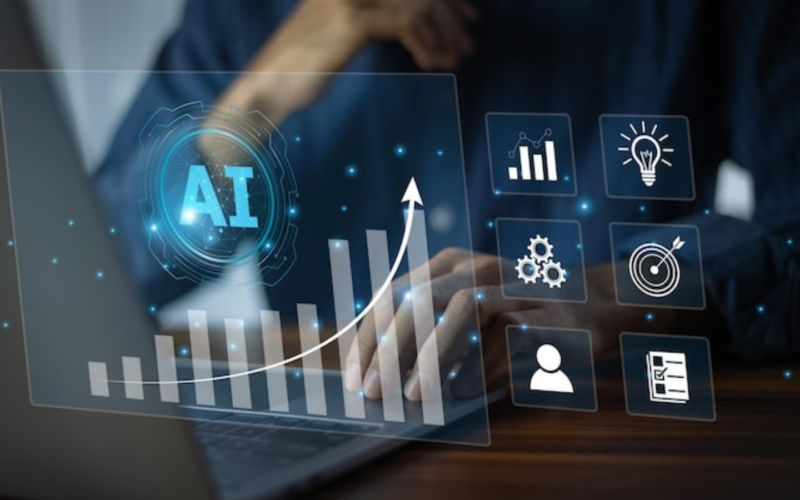The global big data market is projected to exceed $100 billion by 2027, showing just how crucial analytics is for business growth. But if you’re unsure which of the following types of advanced analytics will best help you, you’re not alone.
Whether you’re looking to understand past performance, pinpoint reasons behind issues, or predict future outcomes, finding the right type of analytics is key.
In this article, you’ll learn about the different types of advanced analytics and how each one can help solve your business challenges.
Key Takeaways
- Advanced analytics is evolving from basic reporting to intelligent, AI-powered insights that drive strategic decisions.
- Each type of advanced analytics plays a critical role in helping businesses understand past performance, uncover causes, forecast future trends, and make data-driven decisions.
- Analytics tools must integrate with existing systems, offer scalable AI features, and adapt to changing business needs.
- Codewave offers tailored analytics solutions that provide actionable insights, enhance decision-making, and ensure long-term growth with customized, AI-powered systems.
What is Advanced Analytics?
Let’s say you’re managing a growing retail business, and you’re staring at piles of sales data, customer feedback, and inventory reports. You need to know what’s working, what’s not, and how to drive more sales in the next quarter. The pressure’s on, but you’re unsure which of the following types of advanced analytics will help you get the clarity you need.
For businesses like yours, advanced analytics cuts through the noise, turning data into insights that drive smarter decisions and improve processes. Here’s why:
- Informed Decision-Making: Advanced analytics helps businesses move beyond gut feeling and make decisions based on data, improving accuracy and reducing risks.
- Identifying Trends: It uncovers hidden patterns in data, helping businesses spot emerging trends, market shifts, and customer preferences early on.
- Efficiency Gains: By analyzing processes, businesses can identify inefficiencies and streamline operations, saving both time and money.
- Predicting Outcomes: With predictive models, businesses can forecast future trends, customer behavior, and potential risks, allowing for better planning.
- Improved Customer Experience: Advanced analytics enables businesses to understand customer needs, personalize experiences, and build stronger relationships.
- Competitive Advantage: Using data to drive decisions gives businesses an edge, helping them stay ahead of competitors and adapt faster to market changes.
Having different types of advanced analytics is crucial because each one serves a unique purpose in solving business challenges. While some help you understand what happened, others show why it happened, predict future trends, or guide you on what actions to take.
Looking to make data-driven decisions faster? Explore Codewave’s Data Analytics Development services to unlock actionable insights, optimize performance, and drive growth. Start transforming your data today!
Let’s start with descriptive analytics, the foundation of understanding your past performance.
What is Descriptive Analytics?
You’re running an online store and want to know how your sales performed last month. You’ve got tons of data, but no clear way to make sense of it. This is where descriptive analytics comes in.
It focuses on analyzing historical data to give you a clear picture of past performance. By looking at trends and patterns, you can answer questions like “What was our total revenue last quarter?” or “Which marketing campaign worked best?”
When you’re unsure which of the following types of advanced analytics will provide the clarity you need, descriptive analytics is where you start.
Here are some key concepts you should know:
- Historical Data: Descriptive analytics relies on historical data to provide a snapshot of past performance, helping businesses understand what occurred in specific periods.
- Data Summarization: It aggregates large datasets into simplified summaries, like total sales or average performance metrics, to give businesses a clear overview of past activity.
- Performance Tracking: Descriptive analytics tracks key metrics over time, allowing businesses to measure their performance and compare it against historical benchmarks.
- Comparative Analysis: By comparing different time periods (month-over-month or year-over-year), descriptive analytics helps highlight trends and changes in business performance.
- Time Series Analysis: This involves examining data over specific time frames to identify patterns, such as seasonal trends or cyclical sales fluctuations.
Tools & Techniques
Businesses rely on a variety of tools and techniques designed to simplify, visualize, and interpret data. Here are some key tools and techniques:
1. Data Aggregation Tools
These tools help consolidate and summarize large volumes of data into a usable format. By grouping data into categories (such as total sales, customer visits, or product types), they provide a clear snapshot of past performance.
Examples include Excel, Google Sheets, and business intelligence tools like Power BI or Tableau.
2. Dashboards
Dashboards are interactive data visualization tools that display key metrics and performance indicators in an easy-to-understand format. They allow businesses to monitor real-time data and spot trends instantly, making it easier to track historical performance.
Tools like Tableau, Klipfolio, and Google Data Studio are commonly used for this purpose.
3. Descriptive Statistics
Descriptive statistics provide summary metrics like averages, percentages, and standard deviations to describe the central tendency, spread, and patterns in the data. These are fundamental for understanding overall performance and trends.
Tools like R, Python (Pandas), and Excel are commonly used to calculate these statistics.
4. Time Series Analysis Tools
Time series analysis is a crucial technique in descriptive analytics that focuses on understanding data trends over specific periods.
Tools such as R, Python (Statsmodels), and Tableau are used to analyze historical data points across different time intervals (e.g., monthly sales or quarterly revenue).
5. Reporting Tools
Reporting tools automatically generate structured reports summarizing business metrics, helping businesses track progress over time. They are key for generating periodic reports based on historical data.
Examples include Microsoft Power BI, Google Analytics, and various CRM reporting tools.
6. Data Visualization Tools
Visualizing historical data through charts, graphs, and heatmaps helps to spot trends, patterns, and outliers more easily. These tools simplify complex datasets and make the data more accessible to non-technical users.
Popular tools include Tableau, Power BI, and Google Charts.
Benefits and Challenges
Descriptive analytics offers valuable insights into past performance, but it also comes with its own set of benefits and challenges. Here’s a quick look:
| Benefits | Challenges |
| Provides a clear snapshot of past performance | Relies on accurate and complete data |
| Helps identify trends and patterns over time | Can be misleading if data is outdated |
| Simplifies complex data into actionable insights | Limited in scope, does not predict future |
| Aids in setting benchmarks and measuring success | Can miss underlying causes of trends |
| Enables easy performance tracking | May require regular updates for accuracy |
Next, let’s look at diagnostic analytics and explore how it helps uncover the root causes behind past events.
What is Diagnostic Analytics?
You’re running an online store and notice a sudden drop in sales last month. You’ve got your data, but now you need to understand why this happened. This is where diagnostic analytics comes in.
It dives deeper into historical data to identify the underlying causes of trends and events. By analyzing relationships and patterns, you can answer questions like “Why did sales drop last month?” or “What factors contributed to the success of that campaign?”
Here are some key concepts you should know:
- Root Cause Analysis: Diagnostic analytics helps identify the underlying causes of specific outcomes by analyzing data relationships and patterns.
- Correlation Analysis: It examines how different variables are related, helping businesses pinpoint factors that influenced particular results.
- Data Segmentation: Splitting data into segments (e.g., customer demographics, product types) allows businesses to identify which areas are driving or hindering performance.
- Trend Analysis: This looks at trends over time, comparing fluctuations in metrics to identify potential causes of these changes.
- Drill-Down Analysis: It allows businesses to break down high-level data into finer details, helping to uncover insights that would otherwise be overlooked.
Tools & Techniques
Diagnostic analytics uses specific tools and techniques to analyze past data in depth and uncover underlying causes. Here’s how businesses rely on them:
1. Root Cause Analysis Tools
These techniques help businesses identify the underlying causes of specific outcomes, like why a product launch failed or why customer retention rates dropped. By breaking down problems into smaller components, businesses can find the exact reasons behind performance issues.
Examples: Fishbone diagrams, 5 Whys, Pareto charts.
2. Correlation Analysis Tools
These tools help identify the relationships between different variables. For example, businesses might analyze how factors like ad spend, seasonality, or product pricing influence sales.
Examples: R, Python (SciPy, Pandas), IBM SPSS.
3. Segmentation Tools
Segmentation divides data into specific groups based on shared characteristics, such as customer demographics or product types. This helps businesses understand which segments are driving success or contributing to problems.
Examples: CRM segmentation (Salesforce, HubSpot), R, Python (Scikit-learn).
4. Trend Analysis Tools
These tools help businesses identify and analyze changes in business metrics over time, giving insights into why those changes are happening.
Examples: Tableau, Power BI, R (ggplot2), Python (Matplotlib).
5. Drill-Down Analysis Tools
Drill-down tools allow businesses to break down high-level data into more granular details, making it easier to find the root cause of performance fluctuations.
Examples: Power BI, Tableau, Qlik Sense.
Benefits and Challenges
Diagnostic analytics helps businesses understand the reasons behind performance trends, but like any approach, it comes with its own set of benefits and challenges. Here’s a quick look:
| Benefits | Challenges |
| Helps identify the root causes of performance issues | Requires clean, high-quality data for accurate analysis |
| Improves decision-making by addressing underlying problems | Can be complex and time-consuming to implement |
| Supports targeted improvements and optimizations | May need specialized tools or expertise |
| Provides actionable insights into key business drivers | Risk of misinterpreting correlations as causations |
| Enhances the ability to solve specific problems | Limited by the depth of data analysis available |
Looking to transform your business with AI and Machine Learning? Explore Codewave’s AI/ML Development services to unlock predictive insights, automate processes, and make smarter decisions. Start building intelligent solutions today!
Next, let’s look at predictive analytics, which takes things a step further by forecasting future trends and helping businesses plan for what’s to come.
What is Predictive Analytics?
Suppose you’re running an online store and want to forecast next month’s sales. You’ve got data on past performance, and now you need to predict what’s coming. This is where predictive analytics comes in.
It uses historical data, statistical algorithms, and machine learning to make forecasts about future events or trends. By analyzing past performance and patterns, you can answer questions like “What will our sales be next quarter?” or “How many customers are likely to purchase after this marketing campaign?”
Here are some key concepts you should know:
- Forecasting: Predictive analytics uses historical data to make educated guesses about future events, like sales, customer behavior, or market trends.
- Predictive Modeling: This involves using statistical techniques and machine learning algorithms to create models that predict future outcomes based on past data.
- Trend Analysis: While descriptive analytics looks at past trends, predictive analytics looks at how those trends are likely to continue or change in the future.
- Data Mining: Predictive analytics often involves searching through large datasets to find patterns that can help predict future behavior or trends.
- Scenario Analysis: It involves testing different scenarios to predict how changes in variables (e.g., pricing or promotions) might affect future outcomes.
Tools & Techniques
Predictive analytics uses advanced tools and techniques to forecast future trends and behaviors based on past data. Here’s how businesses rely on them:
- Predictive Modeling Tools
These tools apply statistical techniques and machine learning algorithms to forecast future outcomes based on historical data. Predictive models help businesses anticipate everything from sales trends to customer churn.
Examples: R (caret), Python (Scikit-learn, TensorFlow), SAS.
- Time Series Forecasting Tools
Time series forecasting tools analyze data over time and predict future values by identifying patterns, seasonal variations, and trends.
Examples: R (forecast), Python (Statsmodels), Tableau.
- Regression Analysis
Regression analysis models the relationship between variables to predict outcomes. Businesses can use it to forecast sales based on factors like ad spend, pricing, or customer demographics.
Examples: Excel, R (lm), Python (SciPy).
- Data Mining Tools
Data mining helps identify hidden patterns or relationships in large datasets, which can then be used to make predictions about future events.
Examples: IBM SPSS, RapidMiner, Weka.
- Machine Learning Algorithms
Machine learning techniques like decision trees, neural networks, and ensemble methods can learn from data and improve predictions over time.
Examples: Python (Scikit-learn, Keras), R, TensorFlow.
Benefits and Challenges
Predictive analytics offers a powerful way to forecast future trends and outcomes, but like any tool, it comes with its own set of benefits and challenges. Here’s a quick look:
| Benefits | Challenges |
| Helps businesses anticipate future trends and behaviors | Predictions are only as good as the data and models used |
| Supports proactive decision-making and planning | Requires clean, high-quality historical data for accurate predictions |
| Enables better resource allocation and forecasting | Can be complex and resource-intensive to implement |
| Provides insights into customer behavior and market trends | Risk of inaccurate predictions if the model is not properly tuned |
| Improves long-term strategy and competitive positioning | Requires specialized skills in data science and machine learning |
Next, let’s look at prescriptive analytics, which not only predicts future trends but also recommends the best course of action to achieve desired outcomes.
What is Prescriptive Analytics?
You’re running an online store and have successfully forecasted next month’s sales using predictive analytics. Now, you need to know what actions to take to reach your sales target. This is where prescriptive analytics comes in.
Prescriptive analytics goes beyond predicting future outcomes; it recommends the best course of action to achieve a desired result.
By analyzing various possible scenarios and outcomes, it helps businesses answer questions like “What marketing strategy should we use to boost sales?” or “How should we allocate our budget to maximize returns?”
Here are some key concepts you should know:
- Optimization: This technique helps businesses find the best possible solution to a problem by considering constraints and objectives, such as maximizing profits or minimizing costs.
- Scenario Analysis: Prescriptive analytics tests different possible scenarios to predict the impact of various decisions and help businesses choose the best one.
- Simulation: It uses models to simulate different business scenarios and predict outcomes based on various input conditions.
- Decision Support Systems (DSS): These systems help businesses make decisions by combining data, models, and analytics to generate actionable recommendations.
- What-If Analysis: It helps businesses understand how changes in variables (e.g., pricing, marketing spend) affect outcomes, allowing for better decision-making.
Tools & Techniques
Prescriptive analytics relies on advanced tools and techniques to recommend optimal decisions and actions. Here’s how businesses use them:
- Optimization Tools
These tools help businesses find the best possible solution for complex problems, such as resource allocation, scheduling, or logistics. They use algorithms to maximize or minimize certain outcomes.
Examples: IBM ILOG CPLEX, Gurobi, Excel Solver.
- Simulation Tools
Simulation tools create virtual models of real-world processes to test different scenarios and predict potential outcomes, helping businesses make more informed decisions.
Examples: AnyLogic, Simul8, Arena Simulation.
- Decision Support Systems (DSS)
DSS combines data, analytical models, and business rules to provide actionable recommendations. It helps businesses make informed decisions by integrating complex data and providing solutions in real-time.
Examples: SAP BusinessObjects, Microsoft Power BI, Tableau.
- What-If Analysis Tools
These tools help businesses model different scenarios and see how changes in variables affect outcomes, giving them a clear understanding of potential risks and rewards.
Examples: Excel, @Risk, Crystal Ball.
- Machine Learning Algorithms
Machine learning can enhance prescriptive analytics by continuously learning from new data and improving recommendations over time. Techniques like reinforcement learning can help businesses optimize decisions in real time.
Examples: Python (Scikit-learn, TensorFlow), R.
Benefits and Challenges
Prescriptive analytics provides actionable recommendations to help businesses make the best possible decisions, but it also comes with its own set of benefits and challenges. Here’s a quick look:
| Benefits | Challenges |
| Helps businesses make data-driven decisions | Requires large amounts of high-quality data |
| Provides actionable recommendations to achieve goals | Complex to implement and requires advanced analytics expertise |
| Optimizes resources and processes for maximum outcomes | Can be expensive and resource-intensive to maintain |
| Improves strategic decision-making | May not always account for real-world uncertainties |
| Enhances competitive advantage | Requires continuous updates to reflect changing business conditions |
Now that we’ve explored the different types of analytics, it’s time to understand how to choose the right one for your business needs.
How to Choose the Right Type of Analytics for Your Business
Choosing the right type of analytics is crucial to addressing your business challenges effectively. Whether you’re looking to understand past performance, uncover the causes behind trends, forecast future outcomes, or optimize decision-making, each type of analytics serves a specific purpose.
The key is knowing which of the following types of advanced analytics best aligns with your goals and the questions you need answered.
Below is a detailed table to help you determine which type of advanced analytics is best suited for different aspects of your business.
| Business Need | Descriptive Analytics | Diagnostic Analytics | Predictive Analytics | Prescriptive Analytics |
| Understanding Past Performance | Best suited for summarizing past performance and identifying trends. | Not directly applicable, but can explain why past performance occurred. | Not focused on past performance, but helps with future forecasting. | Provides actionable insights but doesn’t directly explain past events. |
| Identifying Root Causes of Issues | Limited to what happened, doesn’t explore why. | Ideal for uncovering the causes behind performance changes. | Predicts future outcomes, but not focused on causes. | Offers recommendations but doesn’t explicitly explain underlying causes. |
| Forecasting Future Trends | Not applicable as it focuses on past data. | Focuses on historical data and why trends occurred, but not future forecasting. | Best for anticipating future trends, such as sales or customer behavior. | Optimizes for future outcomes, not just forecasting but recommending best actions. |
| Optimizing Decisions | Limited, focuses on historical insights for tracking metrics. | Helps optimize decisions by identifying key drivers of past performance. | Helps forecast potential outcomes based on historical trends, allowing some optimization. | Directly recommends the best course of action to achieve desired outcomes. |
| Improving Customer Experience | Tracks customer interactions and behavior, providing insights into what’s working. | Identifies why customers might be leaving or what’s contributing to their satisfaction. | Predicts future customer behavior, such as likelihood of churn or purchase. | Provides recommendations for personalized experiences based on data-driven insights. |
| Resource Allocation and Budgeting | Helps track past spending patterns and their outcomes. | Analyzes past spending to understand inefficiencies. | Forecasts future budget needs and potential areas for investment. | Recommends how to best allocate resources to maximize returns. |
| Strategic Planning | Provides data on what has worked in the past to guide decision-making. | Helps understand the reasons behind success or failure to refine strategies. | Helps plan for the future by forecasting trends and potential outcomes. | Recommends strategies and actions to achieve optimal results based on predictive models. |
| Operational Efficiency | Provides performance metrics to highlight inefficiencies. | Identifies inefficiencies and helps target areas for improvement. | Predicts where inefficiencies might arise in the future. | Suggests specific operational improvements to enhance efficiency. |
| Handling Uncertainty & Risk | Not focused on uncertainty but provides insights into past risks. | Helps analyze past risks and their causes. | Forecasts potential future risks and trends, such as demand fluctuations. | Recommends actions to mitigate potential risks and uncertainties. |
Looking to streamline your data processes? Explore Codewave’s Process Automation services to enhance your analytics workflows, reduce manual effort, and improve efficiency. Automate your way to smarter, data-driven decisions today!
Incorporating the right type of analytics into your business strategy is key to making informed decisions and driving growth. Keep adapting and understand which of the following types of advanced analytics best fits your evolving business needs to stay ahead of the curve.
Why Choose Codewave for Advanced Analytics?
Curious how Codewave can help elevate your analytics capabilities? Take a look at our portfolio to see how we’ve assisted businesses in implementing advanced analytics systems that go beyond basic reporting.
With Codewave, you get custom-built analytics solutions designed specifically for your business needs. We work with you to create systems that are not only intelligent but also adaptable and scalable, enabling you to unlock the full potential of your data.
What You Get with Codewave’s Advanced Analytics Solutions:
- 60% improvement in analytics speed and efficiency: Enhance your analytics workflows for faster insights, enabling quicker decision-making and better business outcomes.
- 3x faster deployment: Get your advanced analytics systems up and running swiftly, minimizing downtime and accelerating time-to-value.
- Save up to 3 weeks per month: Automate data analysis tasks, reducing manual effort and freeing up valuable time for your team to focus on strategic initiatives.
- 25% reduction in costs: Leverage AI-powered predictive models and optimized processes to lower costs and deliver actionable insights that fuel efficiency and growth.
Our Services Include:
- AI Integration for Advanced Analytics: We tailor AI-driven analytics solutions to enhance your data insights, ensuring scalability and long-term efficiency in decision-making.
- Custom Analytics Solutions: From concept to deployment, we build robust analytics workflows that streamline data processing and performance tracking, giving you actionable insights.
- Advanced AI Features: We integrate AI technologies to enable real-time data analysis, intelligent decision-making, and predictive insights that help guide your business strategies.
- Data Analytics & Optimization: Track performance with intuitive dashboards and continuously optimize your analytics processes for better, data-driven results.
Curious to see what your data is really capable of? Book a free demo with Codewave’s experts and discover how we can turn your data into real results.
FAQs
Q. How can Advanced Analytics improve customer experience?
A. Advanced analytics improves customer experience by providing deeper insights into customer behavior and preferences. By analyzing past interactions and predicting future needs, businesses can personalize their offerings and make proactive decisions. For example, predictive models can forecast customer churn, allowing businesses to act before it happens.
Q. How can I ensure my advanced analytics system stays relevant over time?
A. To keep your advanced analytics system relevant, ensure it evolves with your business needs. Regularly update your models and algorithms to reflect changes in data, industry trends, or customer preferences. Incorporating AI and machine learning ensures that your analytics system can continuously adapt and provide up-to-date insights.
Q. How does Advanced Analytics help with cost reduction?
A. Advanced analytics helps reduce costs by identifying inefficiencies and optimizing resource allocation. By automating data-driven decision-making, businesses can reduce waste and improve operational efficiency. Predictive models also help businesses forecast demand, optimize inventory, and minimize operational risks, ultimately leading to cost savings and better utilization of resources.
Q. How do Advanced Analytics trends affect small businesses?
A. Small businesses can leverage advanced analytics to level the playing field by using data to drive smarter decisions. Analytics tools are becoming more accessible and affordable, helping small businesses improve areas like customer targeting, inventory management, and marketing campaigns. By adopting these trends, small businesses can increase efficiency, reduce operational costs, and improve customer satisfaction without the need for large teams or big budgets.
Q. What should be considered when choosing an Advanced Analytics tool?
A. When selecting an advanced analytics tool, consider the following factors:
- Integration: Ensure it integrates smoothly with your existing data systems and platforms.
- Customization: The tool should fit your specific business needs and workflows.
- Scalability: Choose a solution that can grow with your business as data volumes increase.
- AI & Machine Learning: Look for tools that incorporate AI for deeper insights and smarter predictions.
- Ease of Use: Ensure the tool is user-friendly and doesn’t require extensive technical expertise to operate.
Q. Can Advanced Analytics improve collaboration between departments?
A. Yes, advanced analytics fosters better collaboration by providing shared insights across departments. By using centralized data systems and dashboards, teams from sales, marketing, and customer service can access the same up-to-date information. This enables more coordinated decision-making, faster responses to customer needs, and a unified approach to business strategy.
Codewave is a UX first design thinking & digital transformation services company, designing & engineering innovative mobile apps, cloud, & edge solutions.







